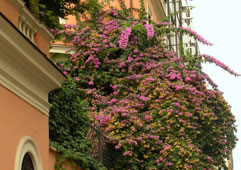Caring for your Bougainvillea
Sun: Bougainvilleas are tropical plants that thrive in areas outdoors with low rainfall and intense heat. For maximum blooming, they need direct sunlight for at least 5 hours per day. Best results are achieved when the night temperatures are above 60°F (15°C). Daytime temperatures can exceed 100°F (38°C) without ill effect. In the absence of sufficient sunlight, if planted in shade or partial shade that results in less than 5 hours of sunlight per day, your Bougainvillea may have healthy vegetative growth, but little or no bract formation or flowering.
Temperature: Bougainvilleas thrive in Hardiness Zones 9 and up, but can be enjoyed seasonally in other zones as either an annual or if protected and brought indoors during winter months. Bougainvilleas are tropical plants, being native to Brazil, and must be protected from frost. In Zone 8 and cooler, we recommend this plant as an annual. When treated as annuals, Bougainvillea can be wintered over in basements or other cool and lower light areas.
Fertilization: Bougainvilleas have a delicate and thin root system, and therefore require special attention when it comes time to fertilization. Use a balanced fertilizer with high Iron and other micronutrients to strengthen delicate roots and intensify color of bracts and foliage. Slow or timed release fertilizers are an acceptable and desirable way to fertilize bougainvillea; however, one must follow label directions. Bougainvillea grow best with small amounts of nutrients available to them constantly. Do not apply fertilizers to dry soil, and do not attempt to over fertilize, since this will not produce faster growth and may, in fact, damage the plant. Both organic and synthetic fertilizers are acceptable sources of plant nutrients. Bougainvilleas are heavy feeders that crave minor nutrients during flowering season, so remember to regularly feed your plant during these months (Sept-Nov) and (Mar-May). Reduce the frequency to half during non-coloring months, especially under cool temperatures.
Spacing: Bougainvilleas grow best when given ample space in well-drained loamy soil (made up of equal parts sand, silt, and clay), mixed with organic matter which allow nutrients and oxygen to more easily reach the roots. When choosing an area to plant your Bougainvillea, remember to plant on higher ground; low ground is not suitable, since water will likely drain towards the roots. Typically plants are grown on trellises next to buildings, but will typically become overgrown if not pruned. Bougainvillea, like most vine like plants, will continue to grow outward without sending out side branches from each leaf-bud point unless the stem is pinched. If you want one long stem, then don't pinch out the tip. By pinching out the tip, most bougainvillea cultivars will send out new stems from 2 to 3 leaf-buds below the cut.
Tips for Vibrant Color: Helping your Bougainvillea achieve its full color potential during season is a function of three important tasks: (1) Regularly feed your plant during the flowering months (Sept-Nov) and (Mar-May); (2) Ensure proper watering by using this simple rule of thumb: Few leaves, but some weak bracts – not enough water; Lots of green leaves, but little color – too much water; A combination of healthy leaves and bracts – just right; (3) Prune the ends of your Bougainvillea regularly, since your Bougainvillea will show color only on new growth. By frequently pinching the ends after each bloom cycle, you can maximize the color on your plants.
Training a Bougainvillea: Drive a tall stake or bamboo pole into the center of the bougainvillea. Tie the bougainvillea to the stake with a soft string or a piece of torn nylon stocking. The tie should be loose enough that it won't cut into the vine or impede its growth. Wrap the bougainvillea vines carefully around the stake, shaping it as you go. Trim off any vines that grow to the side.
Train the vine as it grows, removing any extraneous vines. In time, the bougainvillea should grow around the stake without much help. The same technique can be used to train a bougainvillea on a trellis or arbor.
Planting or Re-potting
Take care not to disturb the bougainvillea’s delicate root system during planting or re-potting. Never pull on the stem of the plant as their weak roots can be easily severed. We highly recommended that you plant bougainvillea in their nursery pots with the bottom of the pot cut out. Use a quick-drain soil suitable for bougainvillea.
Trimming and Pinching
After each blooming cycle (approximately every 4-6 weeks), trim or pinch the soft tips of young plants stems to encourage new growth. Pinching means removing the growing tip. This will create multiple offshoots, thicken the plant’s appearance, and yield a more colorful bougainvillea.

